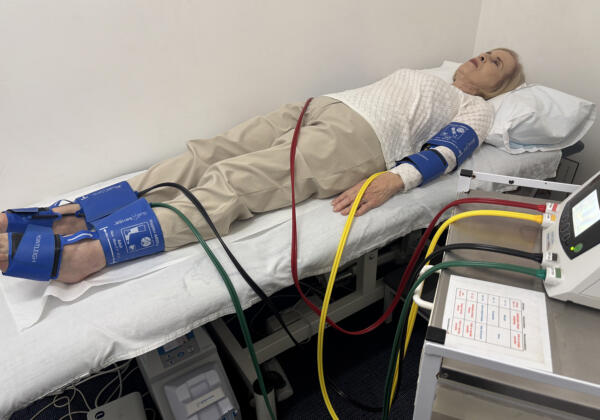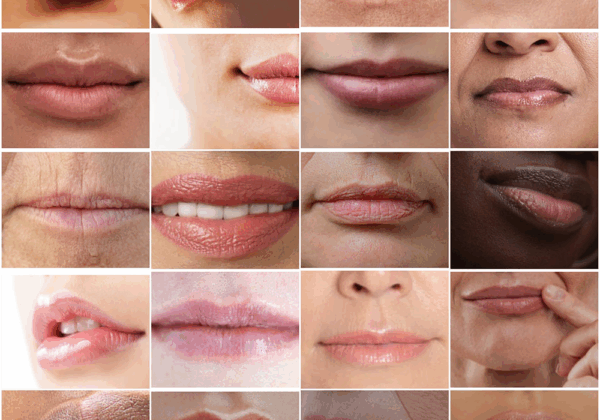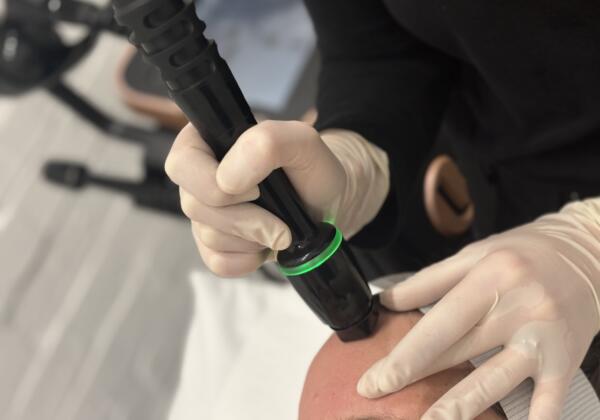Laser Hair Removal at Geelong Veins, Skin & Laser
Lasers for laser hair removal were first created in the 1960s-1970s but the early models caused significant side effects. It was not until the mid 1990s that lasers were refined enough to provide good hair follicle reduction without associated adverse skin effects, and not until this century that they have become widely used.
In 2020 advances in laser technology and availability have made laser hair removal one of the most popular beauty treatments in Australia. It is now so popular that it is near impossible to visit a shopping complex without passing some type of laser or light therapy hair removal clinic. As much as the practice of laser hair removal is now widely available, the quality, type and grade of machines being used and experience of your practitioner will determine the success of your treatment.
Lasers are machines that produce light. The light is of a certain colour or wavelength. The particular colour or wavelength of the laser light will determine the effect it has on your skin. The laser we use for hair removal is attracted to the melanin or pigment part of the hair. The pigment is made in the root of the hair, so the laser light concentrates in the root. If you concentrate light you get heat, if you get enough heat you will kill the hair follicle.
Hair anatomy
A hair grows like a daffodil – the root (hair bulb) is below the surface which connects to the hair shaft then the strand of the hair.
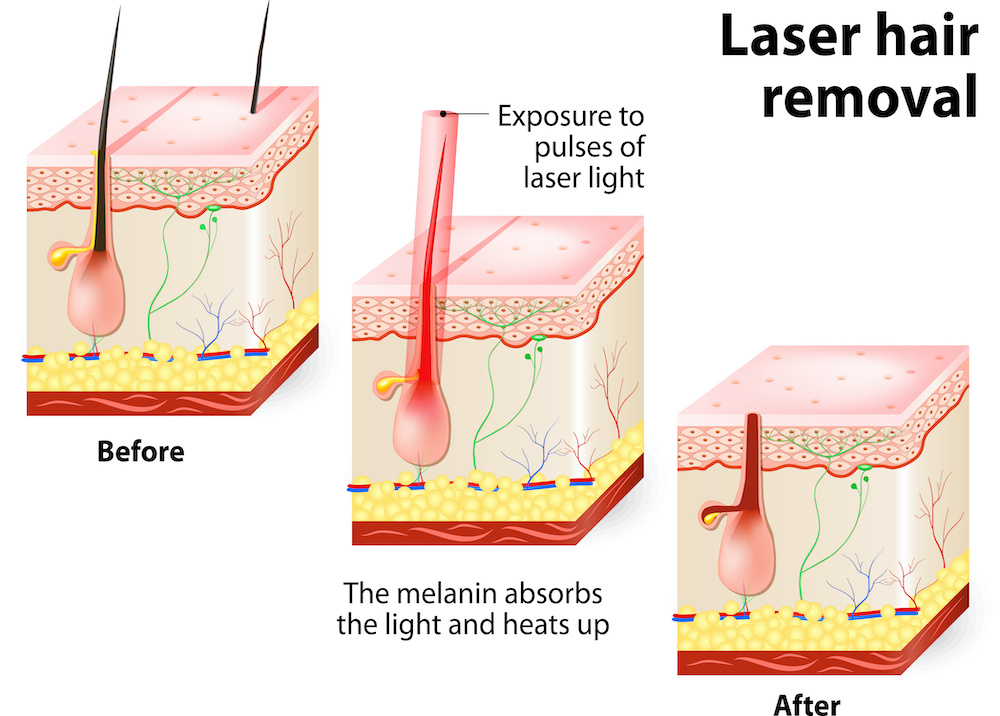
Shaving will take off the surface hair, and the hair will regrow quickly. Waxing will break the hair off about mid shaft, so the hair will take longer to regrow but waxing doesn’t target the root. Also, you often get ingrown hairs as the pore can shut with the hair still growing. To try and get long term removal of hair you need to target the root of the hair.
Electrolysis vs Laser for hair removal
The 2 main methods of targeting the hair root to try and get longer term results are:
- Electrolysis
- Laser and light-based treatment
- Electrolysis has been around a long time and can work well by cutting off the blood supply to the follicle, however its limitations are it can only treat one hair at a time.
- When you pass the needle through the skin you can’t see the root so it is hit and miss and the same hair often needs to be treated several times to be effective.
- As electrolysis breaks the skin surface it tends to be traumatic and quite painful. For large areas it tends to be impractical as it is a slow treatment. For small localized areas or for people not suited to laser because of the colour of their hair (white hair) it can still be a good option.
Advantages of Laser
The advantage of laser hair removal is that we can use a large beam that treats a number of hairs at the same time which makes the treatment quick and suitable for larger areas.
As the laser is a light beam it doesn’t break the surface of the skin so there is no bleeding or risk of infection. The laser also doesn’t irritate the nerve endings as much as in electrolysis so it is less painful. However, the laser certainly can be felt, even though it is a light beam it is concentrated so it feels hot, that is why we use a special laser that has a cooling spray that reduces the sensation as well as protects the skin.
Disadvantages of Laser
The disadvantages of laser are that if a person does not have as much pigment in their hair they will not get as good a result. So, people with blonde, grey and red hair do not respond as well.

Skin type
The other consideration apart from hair type is skin type. Just like the hair contains pigment or melanin so does your skin. If people have a lot of pigment in their skin, we have to be careful that the skin doesn’t absorb too much laser light and get a reaction. This is why we will not treat an area that has a recent suntan. Whilst the hairs will still respond well the skin can react and you may get a sunburn effect which may even result in increased or decreased pigmentation to the skin and scarring. Whilst this returns to normal over a long period of time it is best to avoid it so we recommend not treating recently tanned skin.
Reasonable expectations for laser hair removal
Whilst laser hair removal is the most effective treatment available you should not expect that you will have a certain number of treatments and never have hair ever again as new hairs can grow in the future. Results vary between people and can vary between different areas of the body in the same person.
Facial hair is the most difficult to get long term results as the hair is often hormonal and the laser does nothing to influence hormone levels. The short-term results will be great and you will be very happy however, it is more likely than not with facial hair that you will need maintenance treatments. For some patients this may be every 6 weeks for others it may be 2 or 3 times a year. In older people where the hormonal influence drops off the results with facial hair are often much better and may only require treatment once a year.
Other body areas like the underarms and bikini line tend to respond much better in longer term as they are less hormonal. The majority of patients can get a reduction of 80 – 90% with between 4-6 treatments, some patients come in once a year for maintenance to treat new hairs but this varies with how much hair is there and whether it is cost effective for laser treatment versus other options especially if there are only a few scattered hairs.
With each treatment you should see a progressive reduction in the number and thickness of hairs and if we don’t then we need to reassess the settings on the laser or how responsive your hairs may be.
It is not only the colour of the hair and skin that is important but also the depth of the hair root. If the hair roots are closer to the surface then the laser can more easily reach the hair root and destroy it, however, if the hair roots are very deep the laser may only shock the hair so that it is slow to regrow and not kill it. We do not know how deep individual hair roots are and it can vary. Another factor is the hair growth cycle. At any point in time a certain percentage of your hair will be in a growth phase whilst other hairs will be in a resting phase. When the hair is actively growing it is producing pigment and it is more responsive to the laser treatment. The percentage of your hair that is growing or resting also varies between people and between different areas of your body.
The bottom line with hair removal lasers is that it is the most effective treatment available. Patients are generally very happy with both the short-term results and long-term results, although the number of treatments required can vary from person to person.
Is Laser safe?
Laser treatment has been used on the skin for over 50 years. It is simply concentrated light. There is no ionizing radiation and it is safe compared to X-Rays. It does not damage the DNA of cells so it will not cause any long-term damage to the skin. It definitely does not cause skin cancer.
The main safety precaution is the correct eyewear as laser light can be attracted to the pigment in your eyes. This is why it is important that only correctly trained people do laser hair removal.
NOTE: Some obstetricians advise patients not to have any laser in the first trimester (i.e. first 3 months of pregnancy) just to be on the safe side. If patients are in any doubt we advise them to check with their obstetrician even though there is no evidence of adverse effects.
Is it painful?
The laser is only a light beam however as it concentrates light you will feel a hot sensation on the skin. Most people find it quite bearable and it certainly is not nearly as painful as electrolysis. We use a laser that has a cooling spray and this both dampens down the sensation on the skin as well as significantly reducing skin reaction.
What do I do before treatment?
You don’t have to let the hair grow long as we want to target the root of the hair not the top. On the face you do not have to do anything before treatment but any makeup will need to be removed as pigment in makeup will attract the light and cause some more skin reaction. You can put makeup on straight after treatment. For body areas we prefer a small dark visible hair such as from shaving 1 to 2 days before.
Can I wax or shave before treatments?
Between treatments you should not need to do much as the hair won’t be visible until you are due for another treatment. If, however you are away or it doesn’t suit you to have another treatment then you can definitely shave the area.

Can I bleach?
Bleaching will cut the effectiveness of the laser as bleach removes pigment so we advise no bleaching before laser treatment. If we treat bleached hair the hair will often not be removed at the time of treatment. However, if the roots are still dark you should still get some response.
When can I suntan after treatment?
Strictly for 2 weeks after your treatment you must avoid direct sun exposure or developing a sun tan.
How long do I have to wait after a suntan before treatment?
It will depend on how dark your suntan is. If it is very dark you may need to wait 4 weeks. If it is a light to moderate sun tan we will often wait 2 weeks. In no circumstances will we perform treatment on an area that has fake tan.
Will I get much skin reaction?
The majority of people get some redness that may last 1 to 2 hours and the skin may feel like mild sunburn. However, many people come in before work or during work and nobody will notice they have had treatment done.
What is the difference between laser and IPL?
A laser is a machine that produces a light beam of one colour (or wavelength). Depending on the type of laser will depend on what effect it has on the skin. The laser we use for hair removal just does hair removal and it is very specific in that it just targets hair. The wavelength that our hair removal laser emits (755nm) means it is able to send light and heat right down to the bulb of the hair, causing a more permanent destruction whereas IPL will not be able to send the energy as deep and will mainly target the shaft of the hair or scatter underneath the epidermal tissue, which is not effective in destroying the hair bulb.
IPL stands for Intense Pulsed Light. It is not a laser but a machine that produces broadband light and a filter is placed in front of it to produce a certain band of light (multiple colours). They are much less specific in that they target several structures in the skin not just hair. They are very popular in the beauty industry as the one machine is used to try and treat many skin conditions by changing the filters. They are less specific in their target and so not as effective as lasers. The problem with lasers is that we need to have different lasers to treat different problems and they are very expensive machines. At our clinic we have different lasers for hair removal, birthmarks, tattoo removal, acne scarring, pigmentation, capillaries, leg veins.
What type of laser does Geelong Veins Skin & Laser use for hair removal?
At GVSL we use an Alexandrite hair removal laser. This laser remains the gold standard and most medical based practices tend to use this laser for the majority of hair removal patients. We use an Alexandrite laser called a GENTLELASE. This is made by an American company called CANDELA, one of the largest laser companies in the world. We prefer this laser as it has the best skin cooling system and is the fastest. It uses an 18mm spot size that can be pulsed at 1.5Hertz i.e. one and a half pulses every second.
Visit our Laser Hair Removal Page for more information.
Authored by:
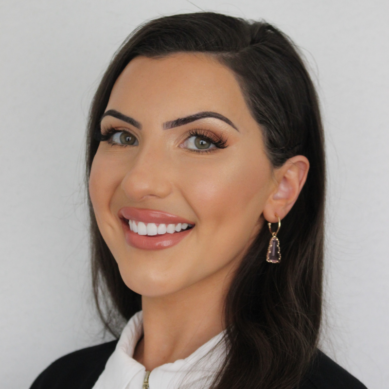
Charlotte Woolfe
Was this page helpful?
 Share
Share

